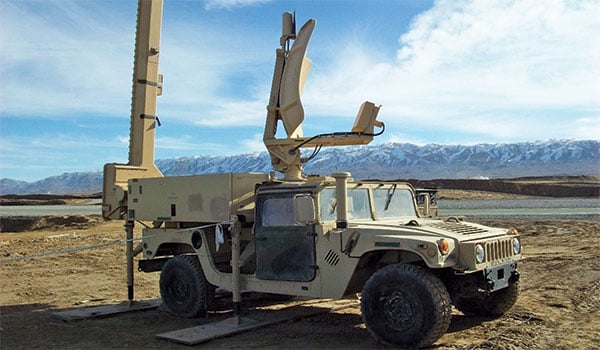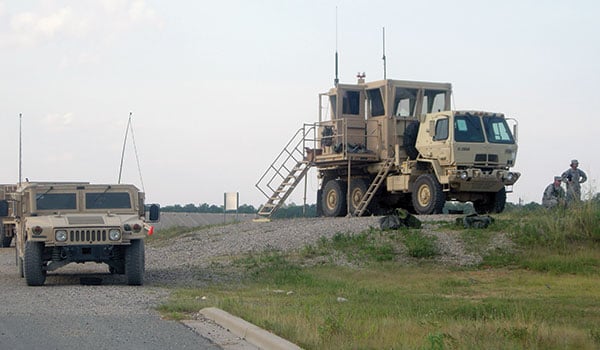
Air Traffic Services / By Mr. John B. Traylor: While flying across the nation to your vacation or business location, have you considered the vast network of air traffic controllers that ensures your flight departs and arrives safely? The same air traffic control (ATC) is needed for Army aviation aircraft, and Army air traffic controllers must have the best systems available to ensure that all Army Aviation operations take off and return safely.

The AN/TPN-31 Air Traffic Navigation, Integration, Coordination System (ATNAVICS) at FOB Wolverine, Afghanistan./PM ATC COURTESY PHOTO
Army ATC is a critical enabler to all Aviation operations, providing risk reduction for military, civil, and general aviation operating at Army airfields throughout the world while supporting Homeland Defense missions and tactical operations. Army ATC encompasses various functions and operational pillars spread across the spectrum of tactical operations that support aircraft operations in theater. These include airspace management, tower operations, radar operations, and all fixed base operations.
PM ATC supports this critical mission by providing the acquisition, fielding, modernization, sustainment, and retirement management of all tactical and fixed base ATC equipment that support aircraft movement worldwide. The current ATC portfolio includes Digital Airport Surveillance Radar (DASR), AN/TPN-31 Air Traffic Navigation, Integration, Coordination System (ATNAVICS), Fixed Based Precision Approach Radar, AN/TSQ-221B Tactical Airspace Integration System (TAIS), AN/MSQ-135 Mobile Tower System (MOTS), AN/TSQ-198 Tactical Terminal Control System (TTCS), AN/TSW-7A Tactical Tower, DoD Advanced Automation System (DAAS), Tactical Non-Directional Beacon (NDB), and various other radios, display systems, voice recorders, automation systems, and switching systems that are utilized in Army airfields worldwide.
The newest product in the PM ATC portfolio is the MOTS. It replaces the aging 7A Tactical Tower, which has been in the field since 1976. MOTS provides the joint force commander a highly mobile, self-contained, integrated, and reliable information system platform for visual and procedural aircraft deconfliction and aircrew force protection in unified action terminal airspace environments. MOTS utilizes a modified S-280 shelter on an M1083A1 Medium Tactical Vehicle (MTV) and is fielded with a Deployable Rapid Assembly Shelter (DRASH) trailer, which hosts two 18 kw generators. MOTS will soon enter full rate production, and will be fully fielded in 2017. The MOTS hosts a full communication suite for the ATC mission and supports world-wide rapid deployment (operational within 45 minutes), hurricane relief, and Homeland Defense missions.

Mobile Tower System (MOTS) supporting a Joint Readiness Training Center rotation, Ft. Polk, LA.
The TTCS provides the Army a rapidly deployable, tactical ATC communication capability. In the next few months, PM ATC will initiate fielding of the modernized TTCS platform which allows the capability to be hosted on an armored or unarmored vehicle. Upgrades include increased situational awareness through Blue Force Tracker, improved user interface, modernized radios, and improved design to enhance maintainability.
The TAIS is a mobile communications and digitized battlefield information system providing air-ground synchronization and airspace integration within the operational environment based on joint service and Army information system inputs. TAIS is specifically designed for information system functions to support mission assessment; planning and execution with tactical displays; integrated information management with other digital mission command systems; real time communications with command posts, air platforms; and decision and planning aids. The TAIS serves as an ATS Airspace Information Center or as an Airspace Control (AC) planning and execution enabler. TAIS also provides interoperability with the airspace planning components of the U.S. Air Force and U.S. Navy, and with the airspace planning and air traffic control systems of other Unified Action Partner forces.
ATNAVICS provides Army and Marine Corps tactical air traffic management at temporary airfields in remote locations and is transportable in a single C-130 aircraft or by a CH-47 Chinook helicopter. This three sensor ground control approach system includes a sensor vehicle (containing primary radar, secondary sensor/identification friend or foe (IFF), precision approach radar (PAR) and associated electronics) and an operations vehicle (containing two controller workstations, radar data processing, and communications equipment). The PAR is used to land aircraft in meteorological conditions where the pilots could not land using visual flight rules (VFR). PM ATC and the U.S. Marine Corps continue to incorporate new technology into ATNAVICS to improve the performance and enhance the network connectivity.
PM ATC’s Fixed Base programs have undergone extensive modernization and improvements in the last few years. As a participant in the joint Department of Defense/Federal Aviation Administration National Airspace System acquisition programs, PM ATC has incorporated the latest surveillance, display processing, and voice communications capability available into its terminal air traffic control facilities.
The Future
Going forward, PM ATC is at a technical renaissance. Just as the 14th century cultural movement is considered the bridge between the middle ages and modern history, current ATC system fielding and modernization efforts are serving as a bridge between closed, obsolete technologies and cutting edge open architecture which include expandable and adaptable modular systems with software incorporating added security layers. These are modern technologies that the Department of the Army is advocating and those that PM ATC is adopting. Previous ATC developmental efforts were executed in a “stove pipe” fashion, each system with a unique set of requirements to provide a particular capability with little to no consideration for interoperability and commonality with other systems. Today’s ATC renaissance is centered on networking, advanced surveillance, and communications. Although a seemingly short list at first glance, the implications across the ATC portfolio are significant. Previously no networked concept or capability existed despite the fact that ATC is by its very nature both a collaborative endeavor and environment. The ability to “network” platforms consisted of direct connect wired “land lines,” technically not far removed from “two tin cans and a few feet of string.” Soon, an ATC airfield network capability will allow ATC platforms to network on an actual local area network (LAN) and share data, voice and physical assets.

Keeping up with aircraft modernization and the transponders on fixed, rotary, and unmanned aircraft, ATC will acquire a compatible passive receiver capable of receiving Mode S, ADS-B, and Mode 5, which will be aggregated and displayed onto a screen within TAIS, MOTS, and TTCS. TOCNET will be the common radio control system that is integrated into all tactical systems, bringing a higher level of commonality and interoperability on the tactical ATC network.
In order to support this inclusion of high tech capability, PM ATC formed a commonality group to analyze, study, identify, and develop potential common hardware and software solutions for use across all platforms in the current ATC platform portfolio. The result is a unified approach to system common hardware such as communications switching systems, radios, antennas and simulation systems. This has also enabled the platform program teams to continue development and modernization with a focus on potential opportunities for continued commonality.
Each year, PM ATC develops upgrades and new capabilities for the Army air traffic controllers. According to a statement from the Federal Aviation Administration, on August 16, 2015 a technical problem, possibly caused by a software upgrade at an ATC center in Virginia, created hundreds of flight delays and cancellations along a large swath of the East Coast. Although there is potential risk with any upgrade, PM ATC goes to great lengths to ensure that the software we develop and field is tested and is qualified to operate in those tactical systems. Rigorous verification, testing, and qualifications are all incorporated into the process that PM ATC uses to ensure that the systems meet quality and performance criteria of the highest level. PM ATC is committed to ensuring the systems we produce, the software we develop, the testing we perform, and the certifications we pursue all collectively add up to make up the world’s greatest collection of ATC systems which enable ATC controllers to perform their missions and effectively ensure safe aircraft operations and effective missions.
Mr. John B. Traylor is the technical chief of the Product Management Office, Air Traffic Control; Project Management Office, Aviation Systems; Program Executive Office Aviation located at Redstone Arsenal, AL.










